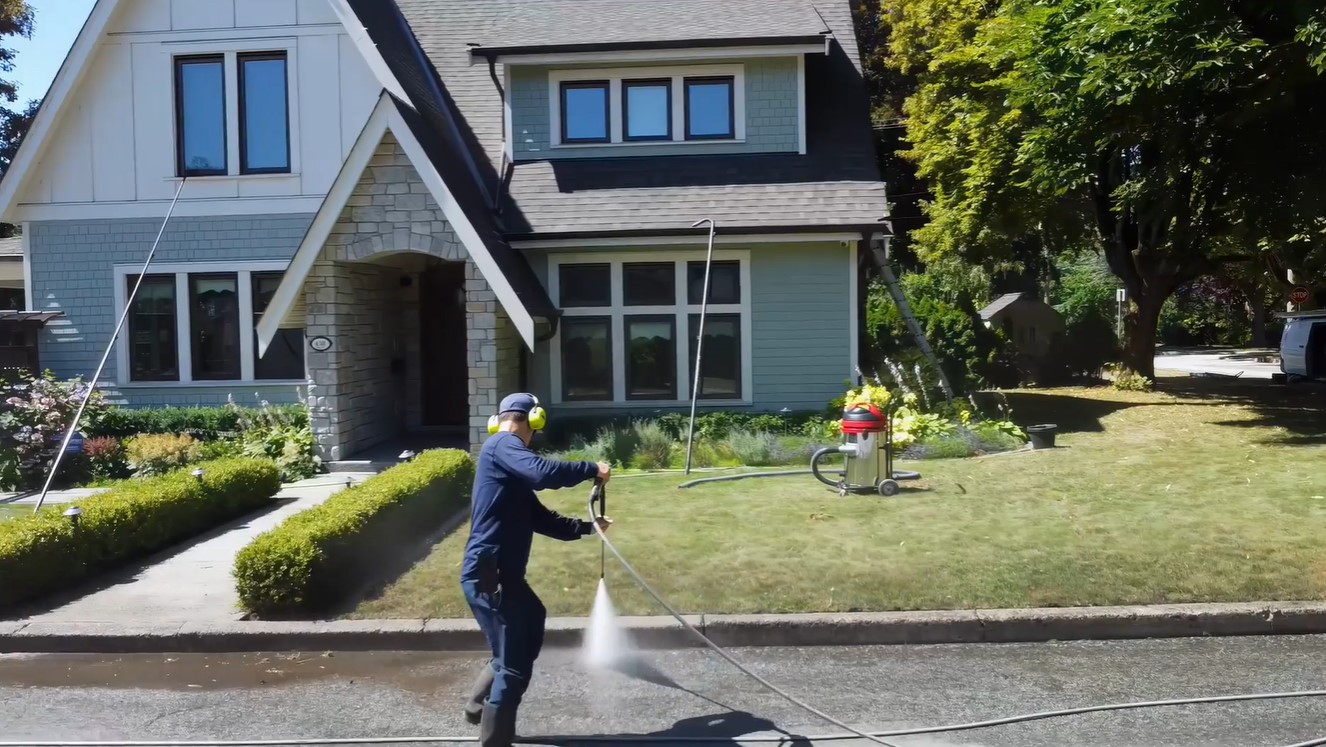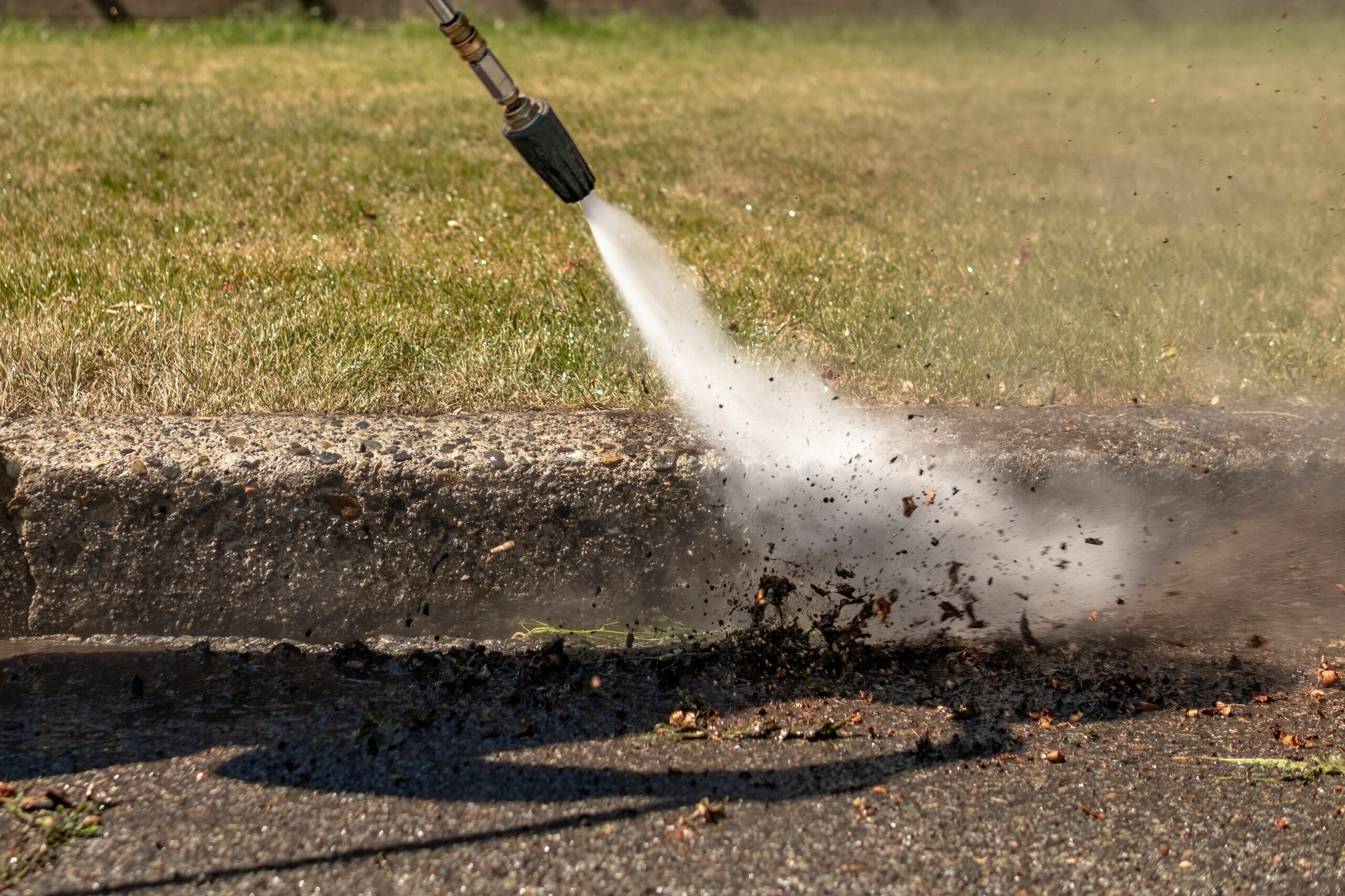
Imagine effortlessly transforming your dingy, weather-worn deck into a pristine outdoor oasis in minutes. With Freeflo Home Services, achieving this incredible makeover becomes a reality. Pressure washers, the unsung heroes of cleanliness, are the tools behind this remarkable change.
Harnessing the raw power of water, pressure washers have a fascinating mechanism that makes grime, mold, and dirt disappear like magic. To clean with confidence, understanding how these pressure washers work is your secret weapon.
In this blog, we’ll explore the secrets of these machines and delve into the science that empowers Freeflo Home Services to enhance your living spaces.
Unlocking the Power of Pressure Washing
Pressure washing, a paramount cleaning technique, involves high-pressure streams of water to eradicate dirt, grime, and other unwanted substances from various surfaces. This method is a powerful ally in restoring a surface’s original appearance and maintaining its safety and functionality.
Regular pressure washing plays a crucial role in preventing mold, mildew, and algae buildup, which, if left unchecked, could result in severe structural harm to surfaces like concrete decks, patios, driveways, and sidewalks.
By efficiently removing these contaminants, pressure washing becomes an essential and cost-effective method for maintaining and prolonging the life of your property. This makes it a wise and valuable investment for both homeowners looking to preserve the curb appeal and value of their residences and business owners aiming to ensure the longevity of their commercial properties.
Components: The Heart of a Pressure Washer
It’s crucial to understand their essential components to demystify how pressure washers work. At the core, these machines consist of three vital parts: the engine, pump, and nozzle.
The gas engine, or an electric motor, provides the necessary power to operate the pressure washer. A water supply, typically from a garden hose, is connected to the pressure washer, feeding the machine with water.
The pump is pivotal in increasing the water pressure, forcing it through a high-pressure hose. The nozzle at the end of the spray gun controls the water flow. It enables the user to direct the high-pressure water stream to remove dirt, grime, and contaminants from outdoor surfaces.
Pressure Generation: How It Works
Pressure washers are designed to create the force needed for cleaning through a relatively simple but effective process. At the heart of the machine lies a powerful water pump, often powered by a gasoline or electric engine. This pump draws in cold water, typically from a garden hose, and boosts its pressure.
The result is that water delivered significantly higher pressure than your regular garden hose. This pressure is measured in pounds per square inch (PSI), and the key here is that pressure washers can generate several times the pressure you’d get from a standard hose.
The Role of Water Flow Rate in Cleaning
In addition to the higher pressure, the water flow rate plays a crucial role in the cleaning process. The rate is usually measured in gallons per minute (GPM), and it determines how quickly the pressurized water is delivered.
The combination of higher pressure and a sufficient flow rate makes power washers effective. The forceful stream of water dislodges dirt and grime and flushes it away. Think of it as a dynamic duo: the pressure is like a high-speed punch, and the flow rate is the swift follow-through, leaving surfaces remarkably clean.
Exploring Nozzle Types for Varied Pressure Effects
Pressure washers come with different nozzle types, and each nozzle affects the pressure of the water stream in a unique way. The nozzles are usually color-coded for easy identification. For instance, a red nozzle delivers a concentrated, high-pressure stream ideal for removing stubborn stains.
In contrast, a green nozzle produces a more expansive, lower-pressure fan pattern suitable for general cleaning. You can fine-tune the pressure and water flow to achieve optimal cleaning results on various surfaces by selecting the proper nozzle for the job. Understanding the nozzle types empowers you to rapidly adapt your pressure washer to tackle a wide range of tasks.
High-Pressure Washing and Power Washing for Stellar Results
Our mission at Freeflo Home Services is to bring you the best in outdoor surface cleaning. We achieve this by using high-quality surface cleaners and high-pressure power washers. These tools ensure we leave no room for dirt, algae, moss, or grime to hide on rigid surfaces and hardscapes. Our trained experts understand the importance of keeping outdoor surfaces in their best condition, so we’re committed to providing effective cleaning solutions that deliver long-lasting results.
Cleaning Driveways, Pathways, and Sidewalks with Precision
Our high-pressure washing and power washing methods excel when it comes to outdoor surfaces like driveways, pathways, and sidewalks. We remove all the built-up dirt, stains, and grime, leaving these areas looking as good as new. Our team is skilled in revitalizing these high-traffic spaces, making your property more inviting and safer.
Reviving Concrete Decks and Patios for Outdoor Enjoyment
Due to dirt, mold, and other contaminants, concrete decks and patios can lose their appeal over time. With our expertise in pressure washing, we rejuvenate these outdoor areas, ensuring you can enjoy your time outdoors to the fullest. Our thorough cleaning techniques restore these surfaces, making them the perfect spot for relaxation and entertainment.
Transforming Cement Exteriors for a Fresh Look
Cement exteriors often bear the brunt of weather and environmental factors, leading to an unsightly appearance. Our high-pressure cleaning methods are tailored to bring back your cement exteriors’ clean and fresh look. Whether it’s your home’s facade or other cemented surfaces, we have the knowledge and equipment to enhance their curb appeal.
Renewing Durable Brick and Stone Exteriors with Care
Brick and stone exteriors, while robust, can accumulate dirt and grime over time. Our pressure-washing specialists know how to deal with these surfaces delicately yet effectively. By using high-pressure washers, we restore the beauty of your brick and stone exteriors, enhancing the overall aesthetics of your property.

How to Operate a Pressure Washer
Safety Precautions
Pressure washers are potent tools but can also be dangerous if not handled with care. To ensure a safe cleaning experience, keep these essential safety precautions in mind:
- Protective Gear: Always wear safety goggles to shield your eyes from debris. Use ear protection as pressure washers can be loud.
- Footwear: Option for non-slip, closed-toe shoes to prevent slips and accidents on wet surfaces.
- Pressure Setting: Start with the lowest pressure setting and gradually increase it as needed to avoid causing damage or injury.
- Distance: Maintain a safe distance from the surface you’re cleaning. Start from a few feet away and adjust accordingly.
- Electricity: When using an electric pressure washer, be cautious with power sources, cords, and outlets to prevent electric shocks.
- Nozzle Handling: Never point the spray nozzle at yourself or others, and be aware of your surroundings to avoid accidental spraying.
- Chemical Use: Follow instructions when using cleaning solutions and ensure proper ventilation.
Step-by-Step Guide
Using a pressure washer effectively can bring stunning results to your outdoor spaces. Here’s a simplified step-by-step guide to get you started:
- Preparation: Clear the area of any objects or debris. Cover delicate plants with a tarp to protect them from the high-pressure spray.
- Connect Water Supply: Attach your garden hose to the pressure washer and ensure a sufficient water supply. Make sure the water is clean and free from debris.
- Nozzle Selection: Choose the appropriate nozzle for your cleaning task. A wide spray pattern is suitable for general cleaning, while a narrow pattern is more intense for tough stains.
- Turn On the Machine: Start the pressure washer according to the manufacturer’s instructions. Be sure to use the correct fuel type for gas-powered models.
- Begin Cleaning: Maintain a safe distance from the surface and start spraying. Keep the nozzle moving consistently sweepingly to avoid streaks or damage.
- Adjust Pressure: Adjust the pressure setting and nozzle distance to achieve the desired results. For tougher stains, you may need to get closer to the surface.
- Rinse and Finish: Once you’ve completed the cleaning process, turn off the pressure washer and disconnect the water supply. Rinse the cleaned surface thoroughly.
- Storage: Store the pressure washer and accessories in a dry, safe place, and follow manufacturer instructions for maintenance.
Conclusion
In summary, understanding how a pressure washer works is the key to achieving efficient and effective cleaning in your outdoor spaces. Armed with this knowledge, you can confidently tackle tasks like driveway, pathway, sidewalk cleaning, and rejuvenating concrete, cement, brick, and stone exteriors.
By comprehending the science behind the machine, you harness its power for remarkable results. If you’re ready to transform your surroundings, why not take the next step? For routine maintenance or a deep clean, contact the professionals at Freeflo Home Services. Our expertise and experience ensure that your pressure washing needs are met excellently.
Contact us today and experience the difference in your home’s curb appeal. Your clean and refreshed outdoor spaces are just a call away.

